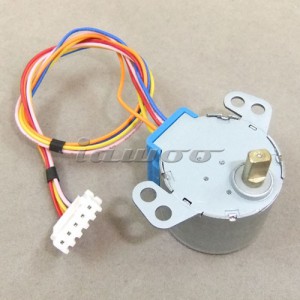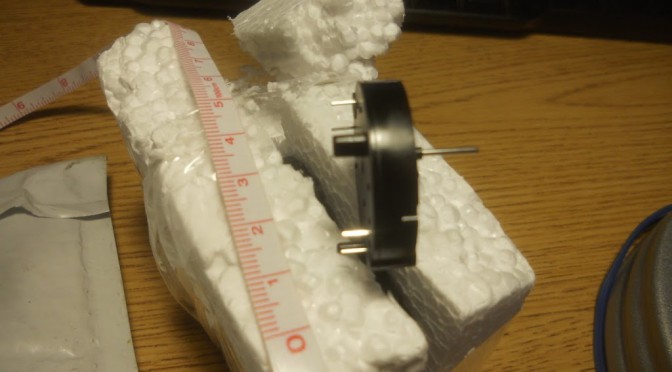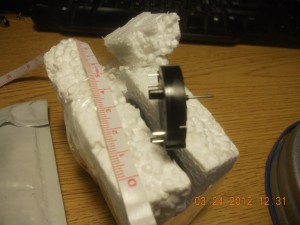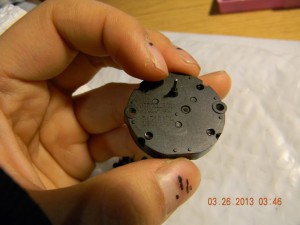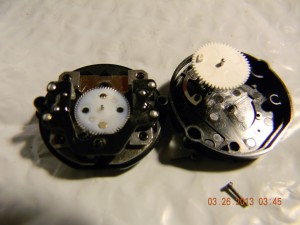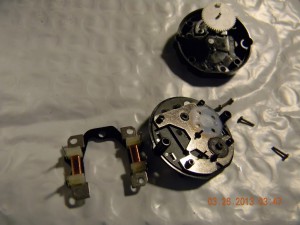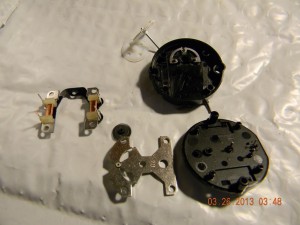Hi all,
(following is a long post, I decided to finally educate myself about 3d printers)
The 2 nozzle machines do not allow for support structure for complex parts.
In case anyone is interested, I consulted my awesome friend (who recently sourced 3d printers for a new shop space) about the resolution issue.
It turns out that resolution in the Z direction is less than in the XY directions so that can be used to differentiate printers. However, it seems that to some extent the limit nowadays on hobby machines is in software, not hardware, for z-axis resolution. In fact, usually (all?) professional 3d printers have to use steppers in the end, so they get similar resolution to hobby machines. Solidoodle and Makerbot Replicator can go down to 0.1mm (3.94 mils). I am uncertain but since this is comparable to listed professional layer heights, the main difference may be speed and lack of support material for overhangs and such.
The main difference between commercial (usu. 10k to 200k) and hobbyist machines(<$10k): one is designing for reals and 3d printing it, the other is design for the 3d printed cools and 3d print it. Partly resolution, partly speed, mainly “the problem with low-cost hobby printers for really professional apps is that they do not do support material.”
=======Technical Discussion (see below for background info)===============
From my friend Charles Guan on support materials:
Not even the [Makerbot] replicator right now does built-in support material, nor Ultimaker
or Solidoodle. If they really want something that they don’t have to think
about designing specifically around the shortcomings for, and especially for
protyping consumer product enclosures or internal assemblies, I think a
commercial machine is worth it [versus hobbyist printer]. Ultimately even $40,000 Stratasys printers are
stepper-driven and get the “same” resolutions.
On the topic of different professional printers,
If they want *sheer resolution* you still can’t beat classic stereolithography
(SLA) processes. Zcorp has the advantage of infinity colors, however. Depends
on if they want prototypes to be structural or not – zcorp prints won’t be able
to act as enclosures or test cases, etc. but SLA plastic generally can. Modern
SLA machines all use DLP to do a whole layer at a time so they can be very
fast. Downside of SLA is the open bucket of light-sensitive goo they use (which
tends to be really expensive, except for this new place
variants, though not sure if a commercial printer would like that)
list of stuff to get. They essentially do UV-cured resin, similar to SLA, but
in a dry form (depositing only what’s needed). Both have much, much better rez
than FDM/extrusion. Can’t think of the numbers off the top of my head though.
On the topic of resolution (what resolution do you need for professional products?):
Depends on what you want… hair is usually 3 mil (.003). 0.01 is a tad rough,
you would see it very clearly. The makerbot Replicator is 0.27mm (0.0068) by
default. For professional product proto’ing I would try to find at least 5 mil
or greater. SLA (stereolithography) and Objets can hit this easily, I think. I have a “beast mode”
setting on the replicator which is 0.5mm (about 19 mil) layers if i am building
something square that just needs fast.
============Background Info====================
Okay, that was hard for me to digest and summarize because I didn’t have the background knowledge, which I present here.
First person pronouns
Industrial 3D printer manufacturers:
(manfuacturer name – printer name – technology used)
Hobbyist 3d printers manufacturers of note: (all FDM process)
- reprap-based machines (tend to be finicky to setup and use),
- Makerbot
- (gen 1 cupcake, finicky and poor mechanical design,
- gen 2 replicator, better designed and support for two nozzle head for multicolored prints)
- Ultimaker – super light moving head for fast printing
- Solidoodle
- a whole host of others, including cake printer (candyfab), chocolate, rice krispy printer…
Technologies
Summary
SLA, DLP, FDM — terms I’d heard before but didn’t know in detail: http://en.wikipedia.org/wiki/3D_printing
(abbreviation, full term, summary, base materials, manufacturer)
- FDM – Fused Deposition Modeling – Poop out lines of heated material that then solidifies (“molten polymer deposition”) – thermoplastics and eutectics – Stratasys
- SLS – Selective Laser Sintering – Dump layer of powder, use laser to fuse parts to keep, repeat (“granular materials binding”) – thermoplastics, metal powders, ceramic powders – EOS
- SLA – Stereolithography – photopolymerization to produce a solid part from a liquid – photopolymers – Objet
- DLP – Digital Light Processing – photopolymers – Object
- Z-corp – Powder bed and inkjet head 3d printing – deposit lines of liquid glue on powder, deposit layer of powder, repeat – Plaster, colored plaster – Z-corp (exclusive)
Full[er] Explanations
FDM http://en.wikipedia.org/wiki/Fused_deposition_modeling
A plastic filament or metal wire is unwound from a coil and supplies material to an extrusion nozzle which can turn the flow on and off. The nozzle is heated to melt the material and can be moved in both horizontal and vertical directions by a numerically controlled mechanism, directly controlled by a computer-aided manufacturing (CAM) software package. The model or part is produced by extruding small beads of thermoplastic material to form layers as the material hardens immediately after extrusion from the nozzle. Stepper motors or servo motors are typically employed to move the extrusion head. If required, support structures are automatically generated. The machine dispenses two materials – one for the model and one for a disposable support structure. The materials are deposited in layers as fine as 0.04 mm (0.0016″) thick,
SLS http://en.wikipedia.org/wiki/Selective_laser_sintering
Selective laser sintering (SLS) is an additive manufacturing technique that uses a high power laser (for example, a carbon dioxide laser) to fuse small particles of plastic, metal (direct metal laser sintering), ceramic, or glass powders into a mass that has a desired 3-dimensional shape. The laser selectively fuses powdered material by scanning cross-sections generated from a 3-D digital description of the part (for example from a CAD file or scan data) on the surface of a powder bed. After each cross-section is scanned, the powder bed is lowered by one layer thickness, a new layer of material is applied on top, and the process is repeated until the part is completed. Unlike some other additive manufacturing processes, such as stereolithography (SLA) and fused deposition modeling(FDM), SLS does not require support structures due to the fact that the part being constructed is surrounded by unsintered powder at all times.
SLA http://en.wikipedia.org/wiki/Stereolithography
Stereolithography is an additive manufacturing process which employs a vat of liquid ultraviolet curable photopolymer “resin” and an ultraviolet laser to build parts’ layers one at a time. For each layer, the laser beam traces a cross-section of the part pattern on the surface of the liquid resin. Exposure to the ultraviolet laser light cures and solidifies the pattern traced on the resin and joins it to the layer below. After being built, parts are immersed in a chemical bath in order to be cleaned of excess resin and are subsequently cured in an ultraviolet oven. After the pattern has been traced, the SLA’s elevator platform descends by a distance equal to the thickness of a single layer, typically 0.05 mm to 0.15 mm (0.002″ to 0.006″). Then, a resin-filled blade sweeps across the cross section of the part, re-coating it with fresh material
Stereolithography requires the use of supporting structures which serve to attach the part to the elevator platform, prevent deflection due to gravity and hold the cross sections in place so that they resist lateral pressure from the re-coater blade. Supports are generated automatically during the preparation of 3D Computer Aided Design models for use on the stereolithography machine, although they may be manipulated manually. Supports must be removed from the finished product manually, unlike in other, less costly, rapid prototyping technologies.
DLP http://en.wikipedia.org/wiki/3D_printing
In digital light processing (DLP), a vat of liquid polymer is exposed to light from a DLP projector under safelight conditions. The exposed liquid polymer hardens. The build plate then moves down in small increments and the liquid polymer is again exposed to light. The process repeats until the model is built. The liquid polymer is then drained from the vat, leaving the solid model. The Objet PolyJet system uses an inkjet printer to spray photopolymer materials in ultra-thin layers (16 micron) layer by layer onto a build tray until the part is completed. Each photopolymer layer is cured by UV light immediately after it is jetted, producing fully cured models that can be handled and used immediately, without post-curing. The gel-like support material, which is designed to support complicated geometries, is removed by hand and water jetting. Also suitable for elastomers.
Powder bed and inkjet head 3d printing http://en.wikipedia.org/wiki/Powder_bed_and_inkjet_head_3d_printing
An inkjet-like printing head moves across a bed of powder, selectively depositing a liquid binding material in the shape of the section. A fresh layer of powder is spread across the top of the model, and the process is repeated. When the model is complete, unbound powder is automatically removed. [For some definition of automatic.. usual requires manual post-processing aka making a giant mess]
Random dump from class notes:
typical feature size — 10 mils. state of art — 1 mils. (lowe resolution than can machine parts). Slow! — hours to print small objects. complex — days.
real point of 3d printers: nested parts and overhang — cannot do in mold [molding and casting procdess]. but need supporting material.
stratasys — water soluble primer
inkjet acrylic droplets — print with wax
dimension 3d printers — has two heads. raster structural and then support material and then next layer. temperatuer of chamber — below fusion temp and much higher than plastic flow so plastic sticks to itself.
have crypto on material cartridges — drm on plastic (can use cheap plastic otherwise). 10k mac shop [yea I don’t remember what this means] — fine but materials are appallingly expensive. Applies to any vendor.
tektronix phaser — inkjet photocurable acrylic. melt wax away to get part and then play with solvents to get wax completely out. fairly fast process b/c heads running in parallel and global uv flash. very nice finish / resolution for same reason.
dimesnion — little fdms — 10 to 40k. big ones, 100k.
InVision — 100k, and $100 for tiny part due to mats.
color 3d printers —
zcorp — everyone dislikes, because? they have powder bed (plaster), spreads layer of powder. straight inkjey heads from hp spreads binder. then powder, then binder. don’t need support material (use unused powder), and add color just in binder.
but disliked because binder does not bind very well. when done printing, try to separate bound from unbound, and sort of bound powder, and everywhere covered. post process to convince to really stick (infuse / dip in wax) together. color but no structure / surface finish. in theory just as fine as invision with droplet size, but due to messiness does not come close.
laser sintering — instead of binder, use laser to print. works with metal powder. issues: machines are alarmingly expensive (few hundred thousand dollars) and metal compacting is not very good.
metal 3d printing — force in metal (injection mold) and squish it. cost does not justify quality.
Hobbyist FDM resolution
http://www.core77.com/blog/digital_fabrication/feedback_friday_solidoodles_sam_cervantes_sets_record_straight_on_desktop_3d_printing_resolution_22398.asp
Best of all Sam Cervantes, the founder of Solidoodle—who clarified some of the technical points on their website following our post—helpfully contacted us to illuminate some of the murkier points of 3D printing resolution. As Sam explains:
… Typically the Solidoodle—and the MakerBot, from my understanding—print layers every 0.3mm (11.8 mils). At Solidoodle we’ve printed as low as 0.1mm (3.94 mils),
Now let’s talk about the resolution in the horizontal (X-Y) plane. The Solidoodle is capable of repeatedly positioning its printhead to within 0.011mm (0.433 mils) … but I did see that they [Makerbot] use 1/16th (62.5 mils) microstepping on their motors.
However, you can see how it’s a little superfluous to say that the resolution in the vertical (Z) direction is 0.3mm and the resolution in the X-Y (horizontal) direction is 0.011mm
… it’s important to remember that the printhead is extruding plastic through a 0.35mm (13.8 mils) nozzle. It’s important to remember that ABS plastic oozes and expands a bit when it comes out of the nozzle . Even though the motor on the automatic sprinkler may be capable of positioning the water nozzle to within millimeters, in the end the water is going to going to spray out of the big nozzle over a wide area in a somewhat random manner.
